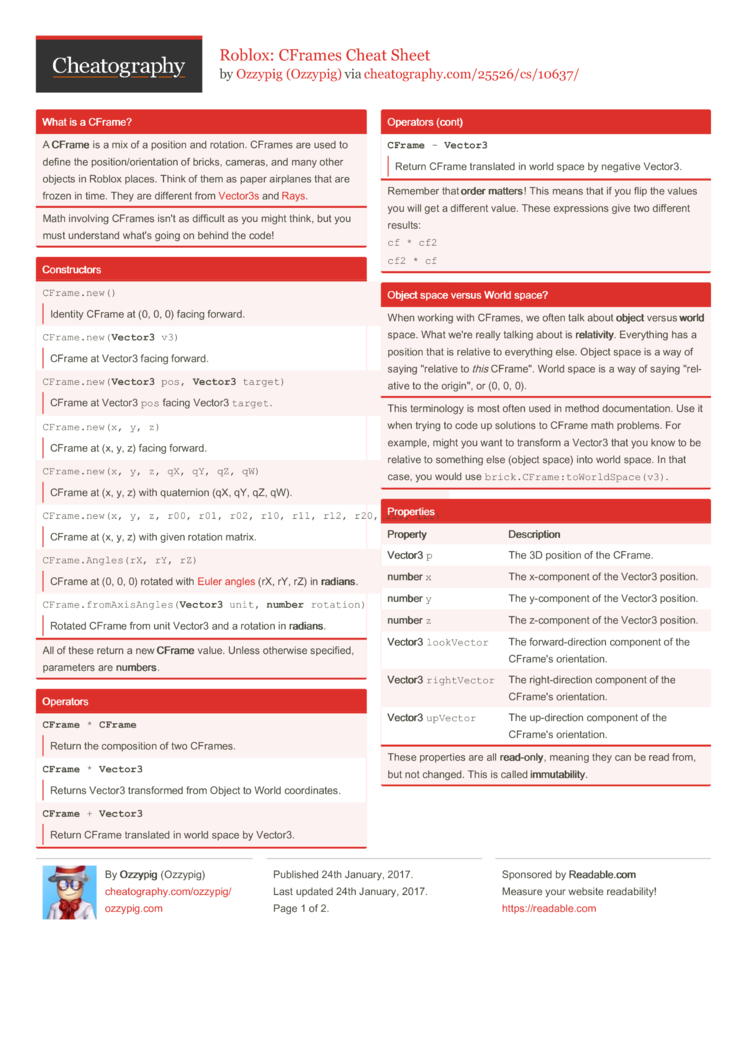Steps to weld:
- Set your Part0 to the character part you’re welding to.
- Set your Part1 to the part you’re welding onto the character.
- Set your C1 (or C0, C1 is better here) to the offset you want. Try CFrame.new (0, -2, 0) for a start.
- Parent your weld somewhere in the workspace. I suggest it’s Part0.
How to make an invisible wall in Roblox Studio?
game:GetService ("Workspace").WhateverPartIsTouched.Touched (function (hit) humanoid = hit and hit.Parent and hit.Parent.Name if humanoid then wallpart.Transparency =1 wallpart.CanCollide = false wait (2) wallpart.Transparency =0 wallpart.CanCollide = true end end I also provides the code here on case if you couldn't find a solution.
How do you Weld bricks on Roblox?
with just c2 and see what happens. Steps to weld: Set your Part0 to the character part you’re welding to. Set your Part1 to the part you’re welding onto the character. Set your C1 (or C0, C1 is better here) to the offset you want. Try CFrame.new (0, -2, 0) for a start. Parent your weld somewhere in the workspace.
How to make shadow in Roblox Studio?
How do you get realistic shadows and good lighting?
- Take a look at this blog post created by the official Roblox Blog. ...
- I think you should watch this video if you would like to make your shadows more realistic. ...
- Realistically speaking, this video covers how to make your lighting stand out in your builds. ...
How to make a Custom rig on Roblox Studio?
- Copy the model into a new place
- Unanchor all the parts in the model with the exception of the HRP
- Copy in a Motor6D into the Torso
- Set the Part0 to the dog’s head part
- Set the Part1 to the torso

How do you weld multiple parts in Roblox?
Use qPerfectionWeld from the toolbox which automatically welds everything together for you. Put the script into your model which has all the parts in it and done.
How do you weld items to players on Roblox?
You select the Character Rig's HumanoidRootPart first, and then the PrimaryPart second, then Weld in place with Moon Animator. Here's how it would work. The next time you clone it, take the Weld object, and replace it's C0 with the character's HumanoidRootPart, and then you're done.
How do Roblox welds work?
A Weld Object is a Roblox object that can bind two parts together, regardless if the parts are or aren't touching. To use a weld object "PartA" and "PartB" must be defined.
How do you add welds in Roblox Studio?
0:542:09Roblox Studio In 2 Minutes: How to Weld (Subtítulos Españoles)YouTubeStart of suggested clipEnd of suggested clipWe'll go to the model tab. Click create select weld you'll see your cursor change to a weldingMoreWe'll go to the model tab. Click create select weld you'll see your cursor change to a welding instrument with a plus sign. Now you'll see it automatically.
How do you Weld a block on Roblox?
Steps to weld:Set your Part0 to the character part you're welding to.Set your Part1 to the part you're welding onto the character.Set your C1 (or C0 , C1 is better here) to the offset you want. Try CFrame.new(0, -2, 0) for a start.Parent your weld somewhere in the workspace. I suggest it's Part0 .
How do you Weld a model to a part?
3:468:17All about Welds in Roblox Studio - YouTubeYouTubeStart of suggested clipEnd of suggested clipAnd the little drop down plus menu go to well constraint. Part 0 will be this part and then part 1MoreAnd the little drop down plus menu go to well constraint. Part 0 will be this part and then part 1 will be this part. And these parts are welded.
How do you join surfaces in Roblox Studio?
Open Studio.Toggle “Join Surfaces” to on.Drag tree model.See white outlines that indicate joining.Drag building model.No white outlines.
Root part
Every Assembly has a root part, see BasePart/GetRootPart. When a Weld’s JointInstance/C0|C0 / JointInstance/C1|C1 is modified the root part will stay where it was.
Directionality
Welds do not have any directionality. JointInstance/Part0|Part0 or JointInstance/Part1|Part1, doesn’t matter. You can imagine rigid joints forming a tree branching down from the root part. All the parts down the tree from root will move, and their welded “children” in this tree will move with them.
Events
Fires when the Instance/Parent property of the object or one of its ancestors is changed.
Code Samples
When instanced via a script, /JointInstance/Part0 of the weld moves to match /JointInstance/Part1. The determination of JointInstance/Part0’s /BasePart/CFrame can be described by the following equation:

Popular Posts:
- 1. how do go into inventory in island royale roblox
- 2. can send messages roblox
- 3. how do you become a hacker in roblox
- 4. how delete roblox cache
- 5. how do friend requests work on roblox xbox one
- 6. how to install roblox on chrome
- 7. how much players are in roblox
- 8. does flamingo have a star code on roblox
- 9. can i buy roblox on robinhood
- 10. how do you fly fast in dragons life 4 roblox